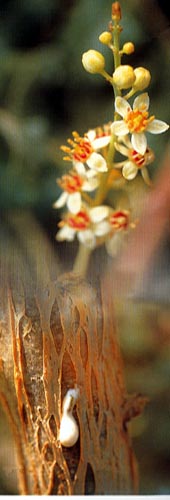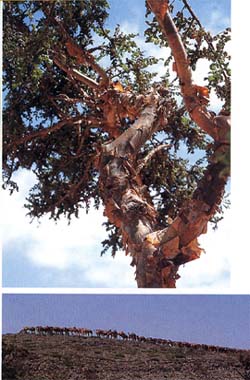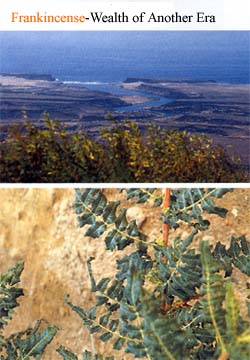|

Frankincense, myrrh and gold are known throughout the
world as the gifts that kings from the East made to the
baby Jesus. Of these three “commodities”, frankincense,
also called oblibanum, was by far the most precious and
expensive. The incense consisted of translucent drops of
crystallized resin from the frankincense tree, which
later became known scientifically as Boswellia sacra.
This shrubby tree grew in the southeast of the Arabian
Peninsula - in the Dhofar and Hadramauth regions. Other
frankincense existed (and still exists) also: in India
from another Boswellia species, Boswellia serrata;
and from Somalia, which had Boswellia frereana as
well as Boswellia sacra. But the best
frankincense was and is produced by the trees that grow
in the Dhofar region and even in one particular area of
the Dhofar - Hasik, 10 km inland from the coast in the
northeast and reached by crossing the pass of Bab-Harkek.
When
you visit Salalah nowadays, the frankincense trees are
not much in evidence - although one specimen flourishes
in the garden of the Holiday Inn Hotel. The wild growing
trees are hidden in the gullies and valleys of the arid
parts of the Qara and Samhan mountains, just outside the
reach of the wet monsoon rains.
Why
was frankincense so famous and valuable?
The
incense has a multitude of medicinal uses and has always
been used in religious ceremonies as well as in royal
households. It is produced by a small tree that looks
insignificant. Its local name is mughur, (mogar, megerot)
or sajerat alluban. It can have many stems, giving it a
bush like appearance. The tree can reach a height of 5
meters but is often much more stunted. The stems are
covered with a reddish-brown bark that loosens into
papery peeling strips. The leaves are feathery, with
small leaflets with crinkly edges. The flowers are
crowded at the end of branches, on small spikes. They
have five white petals and an orange center that turns
black later on. The fruit is a reddish-brown capsule
with one seed in each of its 3-5 compartments. All parts
of the tree contain amounts of resin, an oleo-gum-resin
that is composed of 60-70% alcohol soluble resin and
5-9% volatile oils, with the remainder being
water-soluble resins. It exudes from cuts in the bark
that are either man-made or occur naturally. The opaque
milky substance, called luban or shahaz, dries into
small tear-shaped lumps that crystallize into a clear
silvery solid substance. The essential oil component
contains more than 200 individual natural chemicals that
give the incense its very complex bouquet.
Wild-harvested frankincense is a unique material.
Historically, two different tribes have been involved in
the frankincense harvest: the Jabali’s who live in the
grass lands of the mountains surrounding the Salalah
coastal plain, and the Bedouins from the desert regions
north of the mountains. The Jabali’s are a
cattle-raising community who guarded the vegetation-rich
lower hills from over-grazing and prevented
environmental degradation for thousands of years. The
Bedouins are nomadic and still maintain their old
traditions. They used frankincense when they performed
their morning prayers at the entrances of their houses
and animal-shelters to protect the inhabitants from the
djinn.
The
precious resin is harvested during two seasons: the
spring harvest that lasts from March till May (winter
gum or ‘shahaz estebi’) and the fall harvest that is
from late September till October. The latter season,
called the “kharif”, produces the best resin (shahaz
kharfi), which is white in colour. Of this, the best
resin is produced by the high dry mountains of the Nejd
and is called ‘shahaz negdi’. Each tree belongs to
specific families and the guardianship of these trees is
passed on from generation to generation.
To
harvest the resin, the trees are scored by a
wooden-handled tool with a sharp metal blade, the
mengaff. The resin that flows from the wounds in the
tree bark is gathered in two-week intervals. Only the
material that dries on the tree is collected in the
first instance, although some of the resin flows to the
base of the tree - this is harvested all at the same
time at the end of the season.
The
collected resin is allowed to mature for three months
and is stored on the floor of dry caves.
The
trade and uses of frankincense have been mentioned in
ancient documents. Ptolemy mentioned the
frankincense-producing region as “the mountains of Ophir”,
now thought to be synonymous with the mountains of
Saphar or Dhofar. The Syriac Book of Medicine mentions
remedies, in which frankincense is used. Similar texts
are found in the texts of medieval Muslim practitioners
and in ancient Indian and Chinese medical documents.
During the height of the trade, the harvesting was often
done by slaves and banished criminals. The gum
collectors suffered many hardships, including the many
endemic diseases that exist in the region. The trade was
controlled by whatever king ruled the area at any given
time. Manual de Almeida, a 17th century traveling
Portuguese Jesuit was told that the king of Dhofar and
Qidr owned all the frankincense in the world. De Almeida
was also the first person to describe correctly the
habitat of the frankincense tree: not the verdant lower
seaside hills, but the arid wadis and hills north of the
rainfall area.
The
frankincense trade was the main source of income for the
Dhofar region for almost 5000 years. It was transported
by sea via ports such as Khor Rori with its protective
fort of Samharan and Ganna (with Hisn al Gorab as its
protection) in the Dhofar, and Mukha in what is now
Yemen. From there, it went to India and other parts of
Arabia. However, travel through the Red Sea was fraught
with danger, both from coral reefs and pirates.
Therefore, a land route was developed, first traveled
with donkeys and mules. These, however, needed daily
watering and therefore had to travel complicated zigzag
routes via all the known wells in the desert. Around the
11th century BC camels started to be used as the animal
of transport. These hardy animals could travel without
water for several days, even weeks on end, which made it
possible to travel in straight lines. From a point just
north of the Nejd, the routes ran parallel to the coast
westward and northward. Just before the decline in the
frankincense trade 3000 tons of frankincense were
shipped by camel caravans each year from south Arabia to
Greece, Rome and the Mediterranean world.

Everywhere along the land routes people profited from
this lucrative trade: cities levied taxes at the gates
and at the temples; guards, porters, and servants had to
be bribed; tradesmen sold accommodation, food, animal
fodder and water at the caravanserais; robbers set up
check-points and demanded high bribes for safe passage.
The wealth produced by the frankincense trade supported
many settlements and made them into rich city-states
that could construct sophisticated dams and irrigation
systems, such as at Marib in Yemen. Not only
frankincense was transported via the Incense Route,
but also silks and spices that Omani seafarers had
imported from India and China. This led the Romans to
believe that the kingdoms of southern Arabia produced
these goods. Logically the Romans desired to conquer
these regions that produced such valuable commodities
and sent Aelius Gallus to do so. He never made it
because lack of water kept him in Yemen. It was again
the lack of water, as well as the shifting sands, that
defeated the British explorer Bertrand Thomas in the
1930’s when he tried to explore the ancient frankincense
trail. In the 1980’s NASA’s satellites in space took
pictures that showed faint shadows of a network of roads
under the dunes that in these parts reached heights of
200 to 600 feet. Hundred-meter wide hoof-trodden paths
lay hidden under tons of sand and converged on a point
in the desert that could be the center of the lost
civilization of Ad, the "Atlantis of the sands". In 1990
a scouting expedition that included NASA’s Charles
Elachi and Ronald Blom as well as British explorer
Ranulph Fiennes, Los Angeles attorney George Hedges and
a crew of archaeologists, geologists and documentary
filmmakers looked for geological evidence of a trail to
the once-thriving city of Ubar, the main frankincense
shipping center of Ad. The Ad civilization lasted from
3000 BC to the 2nd century AD and ended when the demand
for frankincense dropped due to worldwide changes in
politics, economics, climate and customs. The explorers
found 900 pottery shards and flint pieces from the Ad
era on this trade route. Excavations had been planned
for 1991 but were postponed due to the first Gulf War.

Even
though the frankincense trade had diminished in the 3rd
century AD, there was still demand for the commodity and
trade continued at a lower level well into the Middle
Ages. Evidence of the use of frankincense was found in
Egypt as charred remains of burnt Boswellia gum on a
1500 year old site (Qasr Ibrimin) as well as from
inscriptions on the tomb of queen Hathsepsut who
apparently used frankincense in the ‘kohl’ that was
apllied as eyeliner.
Many
other medicinal and traditional uses are ascribed to
frankincense. It would be impossible to name all of the
recorded uses, but some of the more interesting ones
have to be mentioned.
The
ancient world believed that incense carried prayers to
heaven. Thus it was used in many different religious
ceremonies. Frankincense was used to embalm corpses.
When the tomb of Pharaoh Tutankhamon was opened in 1922,
one of the sealed flasks released a perceptible whiff of
the incense, after 3000 years! During the funeral of
Roman emperor Sulla an entire statue was made from
frankincense and cinnamon. The annual consumption of
incense at the temple of Baal at Babylon was 2.5 tons.
Herodotus reported: “1000 talents of weight was offered
every year during the feast of Bel on the great altar of
his temple…”
Medicinally it was used by Pliny the elder as an
antidote for hemlock poisoning, while the Iranian
physician Avicenna though it was good for tumors and
fevers as well as dysentery. (Pliny also mentioned that
control of the frankincense trade had made the south
Arabians the richest people on earth).
Discoroides describes that bark of the frankincense tree
can be put into water to attract fish into nets and
traps. Chinese texts of the 12th and 13th century AD
mention 13 different kinds of frankincense used in
medicinal recipes. As late as 1868 the official
Pharmacopeia of India mentions that frankincense can be
used in the treatment of chronic pulmonary conditions
and as an ointment for carbuncles and ulcerations.
Till
today the Dhofari people put frankincense to use both as
medicine and as a beauty treatment:
The
gum is chewed to strengthen teeth and gums as well as
remove mucus from the head. Small pieces of gum are
mixed with salt and inserted into painful hollow teeth.
The smoke from burning gum is considered beneficial for
both man and animals. It is inhaled by people suffering
from headaches. Gum is an ingredient in eyewashes,
dissolves in milk to treat cough, and mixed with wine to
use as a sedative for children and a tranquillizer for
both women in childbirth and those about to be executed.
The bark, dried and powdered is made into a paste to
treat sores and muscle pain, and taken as a stimulating
and cleansing infusion. Fruits and leaves are used as
animal fodder and as a digestive tonic.
The
most well-known use of frankincense is as a fragrance.
The traditional Arabic use is in special incense burner
that are either wafted around the face, or passed
underneath head dresses or clothes, or placed underneath
wooden fumigating tripods to perfume and fumigate
clothing. Distilled extracted essential oils are used in
perfumes such as the famous Omani perfume “Amouage”.
Together with spices and ammonium salts it is also a
component of a special talcum powder to soften the skin.
A
very special grade of frankincense is used for the Quran
recitations of children. Some frankincense pearls are
soaked overnight in water with iron. The child to be
examined drinks the liquid first thing in the morning -
this should improve memory and the chance of success.
An
unusual application is to make long-burning tapers with
a mixture of pitch, sulphur, tow, pinewood sawdust and
powdered frankincense. With these long-burning torches
the dwellings of enemies were set aflame during tribal
wars. More peaceful uses consisted of rinsing old water
skins with frankincense bark and of dyeing cloth and
tanning leather with the bark to a popular mahogany-red
colour, as well as patching broken vessels with the
pliable gum.
From
these few examples we can have a glimpse of a way of
life that is still preserved to a certain extent but is
in danger of passing away. The care and consideration
for the different traditions that surrounded the use of
frankincense are time consuming by modern standards and
thus this traditional heritage is gradually lost.
| 